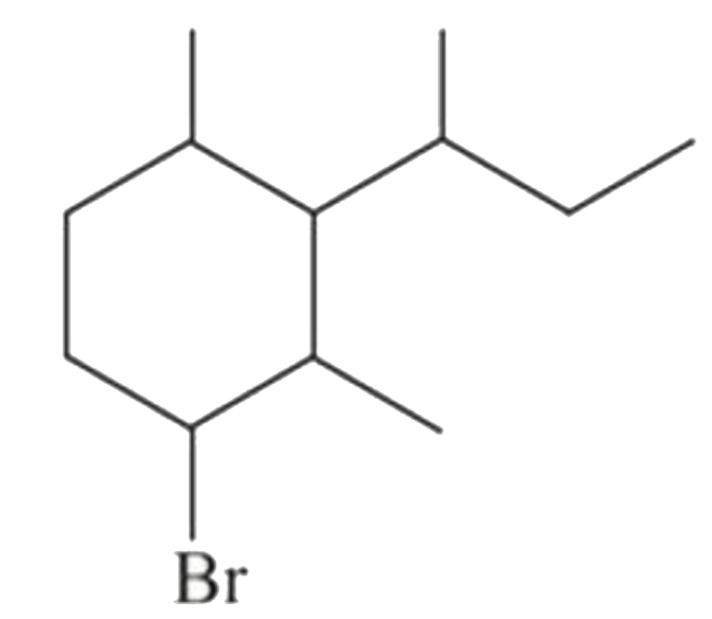On monochlorination of 2-methylbutane, the total number of chiral compound formed is :
2
4
6
8
The correct Answer is:C
To solve the problem of determining the total number of chiral compounds formed from the monochlorination of 2-methylbutane, we can follow these steps:
Step 1: Understand the structure of 2-methylbutane
2-methylbutane has the following structure:
CH3|CH3−CH−CH2−CH3|CH3
This molecule has a total of 5 carbon atoms, with a methyl group attached to the second carbon.
Step 2: Identify the possible positions for chlorination
When monochlorination occurs, a chlorine atom replaces one hydrogen atom. The hydrogen atoms that can be replaced are on different carbon atoms. The possible positions for chlorination are:
1. At the first carbon (C1)
2. At the second carbon (C2)
3. At the third carbon (C3)
4. At the fourth carbon (C4)
Step 3: Determine the products of chlorination
When chlorination occurs at each of these positions, we can analyze the resulting compounds:
1. Chlorination at C1:
- Product: CH2Cl-CH(CH3)-CH2-CH3 (Chiral)
2. Chlorination at C2:
- Product: CH3-CHCl-CH2-CH3 (Not chiral, as it has two identical methyl groups)
3. Chlorination at C3:
- Product: CH3-CH(CH3)-CHCl-CH3 (Chiral)
4. Chlorination at C4:
- Product: CH3-CH(CH3)-CH2-CH2Cl (Not chiral, as it has two identical hydrogen atoms)
Step 4: Identify chiral centers
A chiral center is a carbon atom that has four different substituents. From the products:
1. The product from chlorination at C1 has four different substituents (Cl, CH3, CH2, H) - Chiral
2. The product from chlorination at C2 does not have a chiral center - Not chiral
3. The product from chlorination at C3 has four different substituents (Cl, CH3, CH2, H) - Chiral
4. The product from chlorination at C4 does not have a chiral center - Not chiral
Step 5: Count the total number of chiral compounds
From the analysis, we find that there are two chiral products formed from the monochlorination of 2-methylbutane.
Final Answer
The total number of chiral compounds formed is 2.
---
2-methylbutane has the following structure:
CH3|CH3−CH−CH2−CH3|CH3
This molecule has a total of 5 carbon atoms, with a methyl group attached to the second carbon.
When monochlorination occurs, a chlorine atom replaces one hydrogen atom. The hydrogen atoms that can be replaced are on different carbon atoms. The possible positions for chlorination are:
1. At the first carbon (C1)
2. At the second carbon (C2)
3. At the third carbon (C3)
4. At the fourth carbon (C4)
When chlorination occurs at each of these positions, we can analyze the resulting compounds:
1. Chlorination at C1:
- Product: CH2Cl-CH(CH3)-CH2-CH3 (Chiral)
2. Chlorination at C2:
- Product: CH3-CHCl-CH2-CH3 (Not chiral, as it has two identical methyl groups)
3. Chlorination at C3:
- Product: CH3-CH(CH3)-CHCl-CH3 (Chiral)
4. Chlorination at C4:
- Product: CH3-CH(CH3)-CH2-CH2Cl (Not chiral, as it has two identical hydrogen atoms)
A chiral center is a carbon atom that has four different substituents. From the products:
1. The product from chlorination at C1 has four different substituents (Cl, CH3, CH2, H) - Chiral
2. The product from chlorination at C2 does not have a chiral center - Not chiral
3. The product from chlorination at C3 has four different substituents (Cl, CH3, CH2, H) - Chiral
4. The product from chlorination at C4 does not have a chiral center - Not chiral
From the analysis, we find that there are two chiral products formed from the monochlorination of 2-methylbutane.
The total number of chiral compounds formed is 2.
Similar Questions
Knowledge Check
How many total products will bwe obtained by monochlorination of 2-methyl butane and how many can be separated by fractional distillation?
A6, 4B5, 4C6, 2D4, 2
The chirality of the compound

View SolutionThe Number of chiral carbon in Pencillin is
View SolutionThe number of chiral centres in the given compound is

View SolutionWhich of the following is a chiral compound :
View SolutionWhich of the following are chiral compound.

View SolutionNumber of chiral centers in chloramphenicol is :
View SolutionNumber of chiral centers in chloramphenicol is :
View Solution

